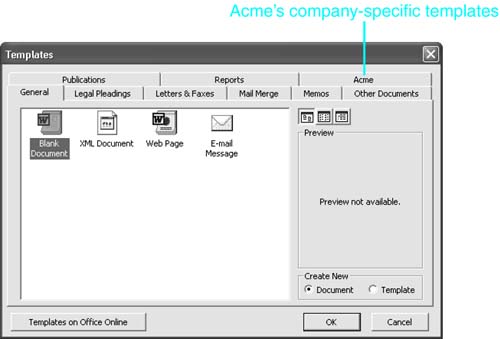Managing Templates to Minimize Your Work
Now that you understand the basics of using and creating templates, you're ready to plan a strategy for using templates to minimize your work and improve the efficiency of all your colleagues.
NOTE
Although our examples assume that you're in a corporation or small business, you can follow the same steps to streamline document production even if you work solo.
Organizing Your Custom Templates
The tabs of the Templates dialog box correspond to folders on your hard disk. The location of the customized user templates you create depends on your configuration and the version of Windows you are running. To find out what folder your user templates are stored in, choose Tools, Options, File Locations, and look for the User Templates listing in the File Types window.
Templates stored in this folder appear within the General tab of the Templates dialog box?the tab that appears when you first open the Templates dialog box. Any subfolders created under this folder appear as tabs within the Templates dialog box.
This means that you can reorganize your templates?even adding new subfolders if you need to. The easiest way to add a new folder is to choose Tools, Options, File Locations; select User Templates; click Modify; and click the Create New Folder button.
You see the results immediately in the Templates dialog box, as shown in Figure 11.13. Note that Word doesn't display empty template subfolders; you must store a template in the folder before that folder will appear in the dialog box.
Figure 11.13. A customized Templates dialog box displaying templates specific to the Acme Company.

It also means that you should move or copy all the templates you use most into the top-level User Templates folder, for quicker access. If you manage Word in a workgroup or department, you can hide or delete the templates or folders you don't want used.
For example, if you standardized on the Elegant family of templates for letters, faxes, and memos, you can copy those into the folder that corresponds to the General tab (in other words, the folder Word is using for your user templates). You can then consider moving unused templates and template subfolders elsewhere on your hard drive so that they do not appear in the Templates dialog box at all.
Think for a moment about how to name your most commonly used templates. Consider including your company's name (or an abbreviated version) in each of them, to make it obvious that these templates are customized to your company's needs.
Further Automating Documents with Templates
Your templates are now model documents that contain all the text and formatting common to all the documents based on them. You've already saved yourself and your colleagues many hours. Your next step is to use the other capabilities of Word templates to build custom editing environments that make you (and your colleagues) even more efficient. To do this, you can draw on various Word features covered in detail elsewhere in the book:
AutoText entries (Chapter 9). Identify blocks of copy that seem to recur often in your documents. For example, many of your company's status reports might include a table that lists steps to be taken next. You can store a skeleton table as an AutoText entry. Then you can use the Organizer to copy this AutoText entry into your Report template.
Styles (Chapter 10). Consider which styles should be used in the documents for which this template is being created. Create those styles, or copy them from documents that already contain them.
Custom toolbars and menu items (Chapter 31). You can include custom menus and/or toolbars in a template. Then, whenever you or anyone else creates a document based on that template, these custom menus and toolbars are there to help. For example, you might create a button on your Report toolbar that inserts an Executive Summary on the first page, using Word 2003's AutoSummarize feature.
Macros (Chapter 32). You can record macros to perform a wide variety of tasks, and if you're comfortable with Word's Visual Basic for Applications (VBA) programming language, you can coax Word to perform an even wider range of tasks.
As you think about your documents, you might find elements that ought to be in them but haven't been added. Now's a good time to create those elements. If you want, you can scour Word's built-in templates and wizards for ideas. An especially good source for business ideas is Word's Agenda Wizard.
If you're using a version of Office 2003 containing PowerPoint, you'll find that PowerPoint is replete with good ideas you can adapt. To find them, either run PowerPoint's AutoContent Wizard or review the templates PowerPoint provides.
TIP
As discussed later in this chapter, if your computers are networked, you can store your global template in a central Workgroup Templates folder that everyone can access. Then, when you make changes to this global template, you can store the new one in Workgroup Templates rather than copy it to everyone's computer.
As is also discussed later in this chapter, you can utilize a folder on a Web server as a central repository for templates for people throughout your organization.
After you're familiar with the Word features involved, you can create a preliminary version of all these templates in just a few hours, excluding VBA macro programming. Try it out. If you're working as part of a team, share it with a few of your colleagues. Modify it as necessary. If you've chosen the right documents to automate, your time investment will pay for itself in just a few weeks?or possibly even a few days.







